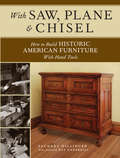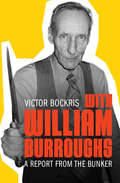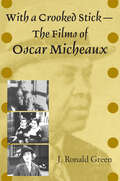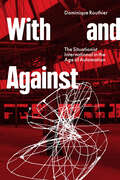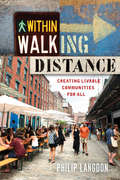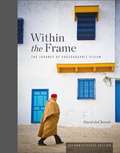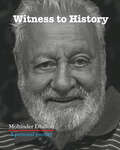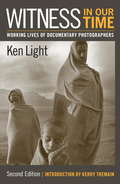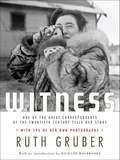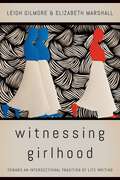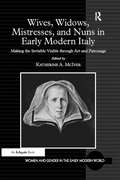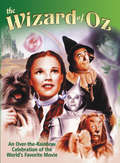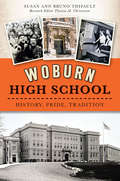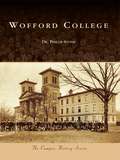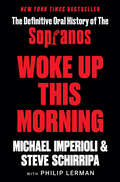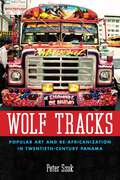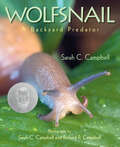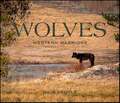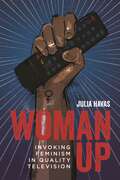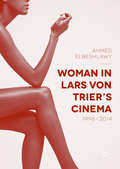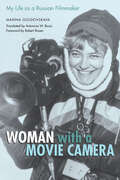- Table View
- List View
With Rommel in the Desert: Tripoli to El Alamein (Images of War)
by David Mitchelhill-GreenThis WWII pictorial history illustrates Nazi Germany&’s North African campaign, showing life under Rommel through vivid wartime photographs. Prior to the outbreak of World War II, the German Army had focused exclusively on preparations needed to wage war in continental Europe. The threat of an Italian collapse in North Africa in early 1941, however, prompted Hitler to aid his ally by sending an armored blocking force to Libya. Not content to merely thwart the British from capturing Tripoli, Lieutenant-General Erwin Rommel harried his inexperienced expeditionary force eastward towards the Nile Delta.With Rommel in the Desert presents a pictorial narrative of the unfolding conflict from the arrival of the Deutsches Afrikakorps until Rommel's departure from the battlefield in March 1943. These rare wartime photographs show daily life in the desert war, with its shifting fortunes and unique challenges. Primarily viewed from the perspective of ordinary combatants, this is their personal record of serving with Rommel in the desert.
With Saw, Plane and Chisel: Building Historic American Furniture With Hand Tools
by Roy Underhill Zachary DillingerBuild furniture the way your ancestors did! Do you enjoy the satisfaction of creating things entirely by hand? Immerse yourself in the world of traditional woodworking as period furniture expert Zachary Dillinger walks you through the hand-tool-only construction of six pieces of classic American furniture. From preparing stock by hand to period-correct joinery methods, you'll learn how our forefathers built furniture--and why they did things the way they did. Within these pages you'll find:An overview of the historical development of major furniture styles from the 1960s through to the mid-19th century--and the European influences from which they evolved.Instruction for period-correct woodworking techniques.Six detailed furniture projects covering popular period styles.Traditional approaches to finishing touches including insights into upholstering by renowned teacher Michael Mascelli and advice from Nancy Cogger of Londonderry Brasses for choosing period-accurate hardware.With Saw, Plane & Chisel shows you how period furniture was made, explains how furniture styles developed and in turn helps you build excellent, realistic heirloom pieces.
With William Burroughs: A Report from the Bunker
by Victor BockrisA trove of intimate conversations between Burroughs and Susan Sontag, Andy Warhol, Patti Smith, David Bowie, and more icons of &’70s New York and beyond. During the 1970s, William Burroughs, author of Junky and Naked Lunch, lived in a loft on the Bowery in New York City&’s Lower East Side. Christened &“The Bunker,&” his apartment became a modern-day literary salon with people like Andy Warhol, Lou Reed, Patti Smith, Susan Sontag, and fellow beat poet Allen Ginsberg passing through for a drink or a joint and the promise of stimulating conversation with the ingenious and eccentric Burroughs. Among Burroughs&’s entourage was author Victor Bockris, whose tape recorder was always running to capture meandering dinner party conversations and electric late-night sessions in the Bunker. In these moments, Bockris captures Burroughs&’s desires, anxieties, and thoughts on writing, photography, punk rock, and more. The recordings and recollections in With William Burroughs create an unprecedentedly multidimensional portrait of a man who is often overshadowed by his reputation.
With a Crooked Stick—The Films of Oscar Micheaux
by J. Ronald GreenWith a "crooked stick," filmmaker Oscar Micheaux (1884–1951) sought to hit a "straight lick" by stressing the strategic importance of class mobility, or "uplift," for African Americans. A theme in all of his more than 40 feature-length, black-produced, black-directed, black-cast, and black-audience films, uplift would allow for the better things in life: fast cars and fancy clothes, freedom of belief, financial security, and an unencumbered intellectual life. Although racism was an impediment to uplift for Micheaux and other African Americans, race as a category was of a secondary order for him in the larger game of class. In With a Crooked Stick, J. Ronald Green pursues this seeming contradiction in a detailed analysis of each of Micheaux's 15 surviving films. He presents critical commentary on each film's plot and action and its contribution to the overall theme of uplift. Readers will also find this an invaluable guide to the preoccupations and features of Micheaux's remarkable career and the insight it provides into the African American experience of the 1920s and 30s.
With and Against: the Situationist International in the Age of Automation
by Dominique RouthierThe little-known story of the Situationist International&’s struggle against the automation of everyday lifeNo other art movement has so profoundly influenced radical politics as the Situationist International. But beyond the clichés about its purported leader Guy Debord, the "society of the spectacle," détournement and dérive, lies a more complex story about key historical shifts in the composition of capital, work, labor, art, and revolutionary theory during the 1950s and 60s.With and Against reframes the history of the Situationist International as a struggle to come to terms with the then-emerging ideologies of cybernetics and automation. Through each of the book's four chapters, Dominique Routhier dissects Situationist pamphlets, documents, artworks, and objects that refract elements of a "cybernetic hypothesis": the theoretically hyperbolic belief that technological progress, computers and automation make class struggle and the idea of revolution obsolete.With equal attention to aesthetic detail and to the broader contours of political economy, this book serves as a critical intervention in art history as well a call to reconsider, more broadly, the contemporary lessons of the most political of all artistic avantgardes.
Within Walking Distance: Creating Livable Communities for All
by Philip LangdonInWithin Walking Distance, journalist and urban critic Philip Langdon looks at why and how Americans are shifting toward a more human-scale way of building and living. He shows how people are creating, improving, and caring for walkable communities. To draw the most important lessons, Langdon spent time in six communities that differ in size, history, wealth, diversity, and education, yet share crucial traits: compactness, a mix of uses and activities, and human scale. To improve conditions and opportunities for everyone, Langdon argues thatplaces where the best of life is within walking distanceought to be at the core of our thinking. This book is for anyone who wants to understand what can be done to build, rebuild, or improve a community while retaining the things that make it distinctive.
Within the Frame: The Journey of Photographic Vision
by David DucheminWhen this book was first published in 2009, it received high praise for both its practical teaching and its humanity. Ten years later, it is a best-selling modern classic and a must-read. Author David duChemins masterful and balanced emphasis on both the head and the heartcraft and technique on the one hand, passion and vision on the othermirror the process of creating compelling, meaningful photographs that convey your vision. <p><p> Filled with engaging photography, thought-provoking text, actionable takeaways, and creative exercises, the books message continues to resonate strongly with readers across the globe. Celebrating a decade since its original publication, this 10th Anniversary Edition of this book has been given a hardcover treatment and an updated, refined design, but retains everything that has made it so well received in over a dozen languages.
Witness To History: A personal journey
by Mohinder DhillonFor almost fifty years, Mohinder Dhillon was one of Africa’s foremost news cameramen and documentary filmmakers. This book is both a personal memoir and a photographic record of the many remarkable events he covered over the course of an extraordinary career – events that were to change the course of history.This book is much more than a collection of photographs. It offers fascinating insights into the behaviour of contemporary African leaders: Emperor Haile Selassie, Jomo Kenyatta, William Tubman, Julius Nyerere, Milton Obote, Idi Amin, Col. Gamel Nasser, Léopold Senghor, Kwame Nkrumah, Muammar Gaddafi and Robert Mugabe among them. Mohinder’s encounters with these and other leading figures of the day took place against the backdrop of the Cold War proxy conflicts that were then tearing Africa apart.While primarily a vivid eye-witness account of the many turbulent events that shaped Africa during and immediately after the colonial era, this wide-ranging memoir also documents events that Mohinder filmed in South Yemen, Vietnam and elsewhere in the world.To the fore throughout is Mohinder’s deep and abiding sense of compassion, both in his approach to photojournalism and as a committed humanitarian.
Witness in Our Time: Working Lives of Documentary Photographers (2nd Edition)
by Ken LightWitness in Our Time traces the recent history of social documentary photography in the words of twenty-nine of the genre's best photographers, editors, and curators, showing how the profession remains vital, innovative, and committed to social change. The second edition includes a new section of interviews on documentary photography in the field and an exploration of the role of photojournalism in 21st-century media. Witness in Our Time provides an insider's view of a profession that continues to confront questions of art and truth while extending the definitions of both.
Witness: One of the Great Foreign Correspondents of the Twentieth Century Tells Her Story
by Ruth GruberWith her perfect memory (and plenty of zip), ninety-five-year-old Ruth Gruber--adventurer, international correspondent, photographer, maker of (and witness to) history, responsible for rescuing hundreds of thousands of Jewish refugees during World War II and after--tells her story in her own words and photographs. Gruber's life has been extraordinary and extraordinarily heroic. She received a B.A. from New York University in three years, a master's degree from the University of Wisconsin a year later, and a Ph.D. from the University of Cologne (magna cum laude) one year after that, becoming at age twenty the youngest Ph.D. in the world (it made headlines in The New York Times; the subject of her thesis: the then little-known Virginia Woolf). At twenty-four, Gruber became an international correspondent for the New York Herald Tribune and traveled across the Soviet Arctic, scooping the world and witnessing, firsthand, the building of cities in the Siberian gulag by the pioneers and prisoners Stalin didn't execute... At thirty, she traveled to Alaska for Harold L. Ickes, FDR's secretary of the interior, to look into homesteading for G.I.s after World War II... And when she was thirty-three, Ickes assigned another secret mission to her--one that transformed her life: Gruber escorted 1,000 Holocaust survivors from Italy to America, the only Jews given refuge in this country during the war. "I have a theory," Gruber said, "that even though we're born Jews, there is a moment in our lives when we become Jews. On that ship, I became a Jew." Gruber's role as rescuer of Jews was just beginning. In Witness, Gruber writes about what she saw and shows us, through her haunting and life-affirming photographs-- taken on each of her assignments-- the worlds, the people, the landscapes, the courage, the hope, the life she witnessed up close and firsthand: the Siberian gulag of the 1930s and the new cities being built there (Gruber, then untrained as a photographer, brought her first Rolleicord with her)... the Alaska highway of 1943, built by 11,000 soldiers, mostly black men from the South (the highway went from Dawson Creek, British Columbia, 1,500 miles to Fairbanks)... her thirteen-day voyage on the army-troop transport Henry Gibbins with refugees and wounded American soldiers, escorting and then photographing the refugees as they arrived in Oswego, New York (they arrived in upstate New York as Adolf Eichmann was sending 750,000 Jews from Hungary to Auschwitz). In 1947, Gruber traveled for the Herald Tribune with the United Nations Special Commission on Palestine (UNSCOP) through the postwar displaced persons camps in Europe, and then to North Africa, Palestine, and the Arab world; the committee's recommendation that Palestine be partitioned into a Jewish state and an Arab state was one of the key factors that led to the founding of Israel. We see Gruber's remarkable photographs of a former American pleasure boat (which had been renamed Exodus 1947) as it limped into Haifa harbor, trying to deliver 4,500 Jewish refugees (including 600 orphans), under attack by five British destroyers and a cruiser that stormed the Exodus with guns, tear gas, and truncheons, while the crew of the Exodus fought back with potatoes, sticks, and cans of kosher meat. In a cable to the Herald Tribune, Gruber reported that "the ship looks like a matchbox splintered by a nutcracker." She was with the people of the Exodus and photographed them when they were herded onto three prison ships. Gruber represented the entire American press aboard the ship Runnymede Park, photographing the prisoners as they defiantly painted a swastika on the Union Jack. During her thirty-two years as a correspondent, Ruth Gruber photographed what she saw and captured the triumph of the human spirit. "Take photographs with your heart," Edward Steichen told her. Witness is a revelation--of a time, a place, a world, a spirit, a belief. It is, above all else, a book of heart.
Witnessing Girlhood: Toward an Intersectional Tradition of Life Writing
by Elizabeth Marshall Leigh GilmoreWhen more than 150 women testified in 2018 to the sexual abuse inflicted on them by Dr. Larry Nassar when they were young, competitive gymnasts, they exposed and transformed the conditions that shielded their violation, including the testimonial disadvantages that cluster at the site of gender, youth, and race. In Witnessing Girlhood, Leigh Gilmore and Elizabeth Marshall argue that they also joined a long tradition of autobiographical writing led by women of color in which adults use the figure and narrative of child witness to expose harm and seek justice. Witnessing Girlhood charts a history of how women use life narrative to transform conditions of suffering, silencing, and injustice into accounts that enjoin ethical response. Drawing on a deep and diverse archive of self-representational forms—slave narratives, testimonio, memoir, comics, and picture books—Gilmore and Marshall attend to how authors return to a narrative of traumatized and silenced girlhood and the figure of the child witness in order to offer public testimony. Emerging within these accounts are key scenes and figures that link a range of texts and forms from the mid–nineteenth century to the contemporary period. Gilmore and Marshall offer a genealogy of the reverberations across timelines, self-representational acts, and jurisdictions of the child witness in life writing. Reconstructing these historical and theoretical trajectories restores an intersectional testimonial history of writing by women of color about sexual and racist violence to the center of life writing and, in so doing, furthers our capacity to engage ethically with representations of vulnerability, childhood, and collective witness.
Wives, Widows, Mistresses, and Nuns in Early Modern Italy: Making the Invisible Visible through Art and Patronage (Women and Gender in the Early Modern World)
by Katherine A. McIVERThrough a visually oriented investigation of historical (in)visibility in early modern Italy, the essays in this volume recover those women - wives, widows, mistresses, the illegitimate - who have been erased from history in modern literature, rendered invisible or obscured by history or scholarship, as well as those who were overshadowed by male relatives, political accident, or spatial location. A multi-faceted invisibility of the individual and of the object is the thread that unites the chapters in this volume. Though some women chose to be invisible, for example the cloistered nun, these essays show that in fact, their voices are heard or seen through their commissions and their patronage of the arts, which afforded them some visibility. Invisibility is also examined in terms of commissions which are no longer extant or are inaccessible. What is revealed throughout the essays is a new way of looking at works of art, a new way to visualize the past by addressing representational invisibility, the marginalized or absent subject or object and historical (in)visibility to discover who does the 'looking,' and how this shapes how something or someone is visible or invisible. The result is a more nuanced understanding of the place of women and gender in early modern Italy.
Wizard of Oz: An Over-the-Rainbow Celebration of the World's Favorite Movie
by Ben NussbaumA celebration of the 75th anniversary of the Metro-Goldwyn-Mayer movie musical, this new book The Wizard of Oz offers a rare glimpse into the creation of the classic film, its creator L. Frank Baum, the Academy Award-winning score, the leading lady, and the Oz phenomenon that continues to captivate the world.<P><P>Although Oz creator L. Frank Baum died twenty years prior to the release of MGM's celebrated film, his fascinating career and story, as told in this new book, will surprise even the most devoted Oz fans. Prior to MGM's 1939 release of the movie, Baum's book was featured as a Broadway musical, with songs by the justifiably forgotten Fred R. Hamlin, and two bizarre silent movies. The enduring appeal and lasting influence of The Wizard of Oz are discussed in a special chapter by creator's great-grandson Roger Baum.The Wizard of Oz will lead the reader down the proverbial yellow brick road to discover:The seven flawless decisions MGM made to adapt Baum's sprawling children's book into a movie musical.The groundbreaking moviemaking techniques, MGM's second full-length Technicolor film.The surprising story behind Harold Arlen and E.Y. Harburg's superlative score, which includes "Over the Rainbow," considered the greatest movie song of all time.How Judy Garland won "Dorothy," her most enduring role, after 20th Century Fox refused to loan Shirley Temple to MGM.The birth of film's greatest canine star, Cairn Terrier, Terry, as Dorothy's little dog "Toto".The many everyday Oz expressions that come from the most oft-quoted movie of all timeHow the Wicked Witch of the West (renamed her Elphaba after Oz creator's initials) was remade "for good" in Broadway's Oz prequel Wicked.This celebration of the iconic film is a must-have for all Wizard of Oz lovers.
Woburn High School: History, Pride, Tradition (Landmarks)
by Susan Ann Thifault Theresa M. ChristersonWoburn High School has instilled the importance of education in generations of students for over 160 years. The school opened its doors in 1852 with thirty-four students in a leased room at the Knight Building on Main Street. Increasing enrollment and curriculum requirements necessitated the building of a larger school on Main Street in 1854 and again in 1906 at the Dow Farm property on Montvale Avenue. Woburn's reputation as a leading leather manufacturer during the Civil War inspired the Tanner nickname, bull mascot and school motto: "Tanner Pride." With the leadership of thirteen principals throughout its history, over thirty-two thousand students have graduated from this school. Today, more than half the faculty are returning alumni, and generations of Woburn families continue to send their children to this school. Join author Susan Thifault as she explores a history of pride and tradition at Woburn High School.
Wofford College (Campus History)
by Dr Phillip StoneFounded with a bequest of $100,000 from the Reverend Benjamin Wofford, Wofford College opened in Spartanburg, South Carolina, in August 1854. More than 150 years later, the college remains on its original campus, a national arboretum. Five of its earliest six buildings are in daily use. Throughout its history, Wofford has maintained its connection with South Carolina Methodism and has benefited from the support of its alumni. Many of its 15,500 living alumni maintain strong ties to the college and to each other. The awarding of a chapter of Phi Beta Kappa in 1941 recognized the college's dedication to the liberal arts and its commitment to academic excellence. Though the student body has grown from around 500 before World War II to nearly 1,500 in 2010, Wofford retains its commitment to developing relationships between students and professors.
Wohnen in der individualisierten Gesellschaft: Psychologisch kommentiert
by Antje FladeWohnen bedeutet Verortet sein, Schutz, raumzeitliche Ordnung, Selbstbestimmung und soziale Einbindung. Wie Menschen wohnen, unterliegt gesellschaftlichen Einflüssen, so dass sich durch die Individualisierung der Gesellschaft auch das Wohnen verändert. Die demografische Entwicklung, zunehmendes technisches Know-how, die Fortentwicklung der Informations- und Kommunikationstechnologie, vermehrte räumliche Mobilität und die anhaltende Verstädterung machen den Menschen zunehmend zum allein wohnenden Einzelwesen ohne tief reichende örtliche und soziale Bindungen.
Woke Up This Morning: The Definitive Oral History of The Sopranos
by Steve Schirripa Michael Imperioli"Essential for fans, with a revelation on every page." —Kirkus Reviews"A spectacular tell-all...the ultimate book on The Sopranos, made by the people who lived it." —Publishers Weekly <P><P>The definitive oral history of the landmark television series and streaming hit The Sopranos, packed with untold stories from behind the scenes and on the set. Stars Michael Imperioli and Steve Schirripa—whose Talking Sopranos podcast has become a sensational fan favorite—talk intimately with virtually everyone who has been involved with the show. And they're ready to spill it all.Who made the phone call that got HBO to launch The Sopranos? What’s the significance of all those eggs? And, what the hell ever happened to the Russian? Michael Imperioli, Steve Schirripa, and the entire cast and crew of The Sopranos have all the answers—and they’re revealing where all the bodies are buried. <P><P> Inspired by the incredibly successful Talking Sopranos podcast, The Sopranos stars Michael Imperioli (Christopher Moltisanti) and Steve Schirripa (Bobby Baccalieri) will finally reveal all the Soprano family secrets in a surprising, funny, and honest new book. Woke Up This Morning will be the definitive behind-the-scenes history of the groundbreaking HBO series that became a worldwide cultural phenomenon, ushered in a new Golden Age of Television, and to this day continues to be one of the most binged shows of all time.Expanding on the podcast with exclusive interviews with the cast, crew, producers, writers, directors, and, of course, the series creator David Chase, Michael and Steve will tell all the incredible stories that The Sopranos fans have been waiting to hear for over twenty years. <P><P> The book will cover the entire history of The Sopranos series from the original concept pitch and casting to the infamous cut to black—and answer many of the thousands of fan questions sent to the podcast, as well as dispel some widely propagated myths and reveal things no one outside the show would even know to ask. <P><P><b>A New York Times Best Seller</b>
Wolf Tracks: Popular Art and Re-Africanization in Twentieth-Century Panama (Caribbean Studies Series)
by Peter SzokPopular art is a masculine and working-class genre, associated with Panama's black population. Its practitioners are self-taught, commercial painters, whose high-toned designs, vibrant portraits, and landscapes appear in cantinas, barbershops, and restaurants. The red devil buses are popular art's most visible manifestation. The old school buses are imported from the United States and provide public transportation in Colón and Panama City. Their owners hire the artists to attract customers with eye-catching depictions of singers and actors, brassy phrases, and vivid representations of both local and exotic panoramas. The red devils boast powerful stereo systems and dominate the urban environment with their blasting reggae, screeching brakes, horns, sirens, whistles, and roaring mufflers. Wolf Tracks analyzes the origins of these practices, tying them to rebellious, Afro-American festival traditions, and to the rumba craze of the mid-twentieth century. During World War II, thousands of US soldiers were stationed in Panama, and elaborately decorated cabarets opened to cater to their presence. These venues often featured touring Afro-Cuban musicians. Painters such as Luis “The Wolf” Evans exploited such moments of modernization to challenge the elite and its older conception of Panama as a country with little connection to Africa. While the intellectual class fled from modernization and asserted a romantic and mestizo (European-indigenous) vision of the republic, popular artists enthusiastically embraced the new influences to project a powerful sense of blackness. Wolf Tracks includes biographies of dozens of painters, as well as detailed discussions of mestizo nationalism, soccer, reggae, and other markers of Afro-Panamanian identity.
Wolfsnail: A Backyard Predator
by Sarah C. CampbellA Theodor Seuss Geisel Honor BookPerfect for kids interested in animals, science, and the world of their backyard, this photographic story of a day in the life of a wolfsnail offers a dramatic introduction to a little-known predator and the impact it has on habitats where it does not belong.On a typical day, the wolfsnail hunts its prey: other snails. Big, strong, and fast (for a snail), the wolfsnail has a taste for meat, and in some areas, it is called the cannibal snail. On the prowl, the wolfsnail finds the slime trail of a smaller snail and follows the path toward its prey. When the chase ends and the dramatic feast is done, nothing remains of the smaller snail... except an empty shell. Slithering and suspenseful, this enlightening book also includes amazing facts about the wolfsnail and a glossary.
Wolves: Western Warriors
by Julie ArgyleIn Wolves: Western Warriors, the life of the powerful and majestic North American wolf, often considered to be vermin and dangerous, is presented, showing the struggle they have to simply survive in the wild and in a world where many people don’t appreciate wolves and often set out to exterminate them. Argyle explores their behavior, their family dynamics, and what it means to be a wolf in the wilderness of the greater Yellowstone area through her stunning photography. She includes information about the reintroduction of wolves to Yellowstone and the ongoing struggle with keeping wolves listed as endangered species, while also offering her personal observations about the Wapiti Lake pack, among others, and several notable individual wolves. The strikingly beautiful images and the information and stories woven throughout the pages of the book showcase this frequently misunderstood, yet completely incredible species.
Woman Into Space: The Jerrie Cobb Story
by Jerrie Cobb Jane ReikerFascinating autobiography of the pioneering female pilot and women’s advocate Jerrie Cobb.Jerrie Cobb (1931-2019) was teaching men to fly by the age of 19, and in her twenties set several records for speed, distance and altitude. She was part of the Mercury 13, a group of women who, in a privately funded venture in 1959, underwent the same physiological testing that the men of the Mercury 7 program were subjected to. She was the first of the group to undergo the testing and the only one to pass all three phases. Nevertheless she was not considered a candidate for space travel by NASA, though she was appointed as a consultant to the space program in 1961.
Woman Up: Invoking Feminism in Quality Television (Contemporary Approaches to Film and Media Series)
by Julia HavasWhile American television has long relied on a strategic foregrounding of feminist politics to promote certain programming’s cultural value, Woman Up: Invoking Feminism in Quality Television is the first sustained critical analysis of the twenty-first-century resurgence of this tradition. In Woman Up, Julia Havas’scentral argument is that postmillennial "feminist quality television" springs from a rhetorical subversion of the (much-debated) masculine-coded "quality television" culture on the one hand and the dominance of postfeminist popular culture on the other. Postmillennial quality television culture promotes the idea of aesthetic-generic hierarchies among different types of scripted programming. Its development has facilitated evaluative academic analyses of television texts based on aesthetic merit, producing a corpus of scholarship devoted to pinpointing where value resides in shows considered worthy of discussion. Other strands of television scholarship have criticized this approach for sidestepping the gendered and classed processes of canonization informing the phenomenon. Woman Up intervenes in this debate by reevaluating such approaches and insisting that rather than further fostering or critiquing already prominent processes of canonization, there is a need to interrogate the cultural forces underlying them. Via detailed analyses of four TV programs emerging in the early period of the "feminist quality TV" trend—30 Rock (2006–13), Parks and Recreation (2009–15), The Good Wife (2009–16), and Orange Is the New Black (2013–19)—Woman Up demonstrates that such series mediate their cultural significance by combining formal aesthetic exceptionalism and a politicized rhetoric around a "problematic" postfeminism, thus linking ideals of political and aesthetic value. Woman Upwill most appeal to students and scholars of cinema and media studies, feminist media studies, television studies, and cultural studies.
Woman in Lars von Trier’s Cinema, 1996–2014
by Ahmed ElbeshlawyThis book discusses the figure of Woman in Lars von Trier’s distinctive cinematic productions from 1996 to 2014. It takes the notorious legacy of violence against women in von Trier’s cinema beyond the perceived gender division, elevating the director’s image above being a mere provocateur. By raising fundamental questions about woman, sexuality, and desire, Elbeshlawy shows that Trier’s cinematic Woman is an attempt at creating an image of a genderless subject that is not inhibited by the confines of ideology and culture. But this attempt is perennially ill-fated. And it is this failure that not only fosters viewing enjoyment but also gives the films their political importance, elevating them above both commendations and condemnations of feminist discourse.
Woman with a Movie Camera: My Life as a Russian Filmmaker (Constructs Series)
by Marina GoldovskayaMarina Goldovskaya is one of Russia's best-known documentary filmmakers. The first woman in Russia (and possibly the world) to combine being a director, writer, cinematographer, and producer, Goldovskaya has made over thirty documentary films and more than one hundred programs for Russian, European, Japanese, and American television. Her work, which includes the award-winning films The House on Arbat Street, The Shattered Mirror, and Solovky Power, has garnered international acclaim and won virtually every prize given for documentary filmmaking. In Woman with a Movie Camera, Goldovskaya turns her lens on her own life and work, telling an adventurous, occasionally harrowing story of growing up in the Stalinist era and subsequently documenting Russian society from the 1960s, through the Thaw and Perestroika, to post-Soviet Russia. She recalls her childhood in a Moscow apartment building that housed famous filmmakers, being one of only three women students at the State Film School, and working as an assistant cameraperson on the first film of Andrei Tarkovsky, Russia's most celebrated director. Reviewing her professional filmmaking career, which began in the 1960s, Goldovskaya reveals her passion for creating films that presented a truthful picture of Soviet life, as well as the challenges of working within (and sometimes subverting) the bureaucracies that controlled Russian film and television production and distribution. Along the way, she describes a host of notable figures in Russian film, theater, art, and politics, as well as the technological evolution of filmmaking from film to video to digital media. A compelling portrait of a woman who broke gender and political barriers, as well as the eventful four decades of Russian history she has documented, Woman with a Movie Camera will be fascinating reading for a wide audience.
Woman's Hour: Daily Meditations from Wise, Witty and Wonderful Women
by Una McCormackFor 75 years, Woman’s Hour has brought us the most iconic and inspirational women from all over the world, delving into their lives and opinions, desires and lessons to others. Now, their wise words are brought to you each day in this daily guide.Woman’s Hour: Daily Meditations from Wise, Witty and Wonderful Women gives you a memorable quote to start your day, from a woman that has made us laugh, made us think and made us act, paired a thoughtful reflection on what that quote is teaching us. Featuring names such as Rosamund Pike, Jacqueline Wilson, Nina Simone, Annie Lennox, Mary Quant, Toni Morrison, Philippa Perry, Sandi Toksvig, Malala Yousafzai, Emma Thompson and many more, the topics range from the workplace to family, friendships to love, ageing to food, and just about everything in between.Start your day with the wisdom of these witty and wonderful women, from over 75 years of Woman’s Hour.

